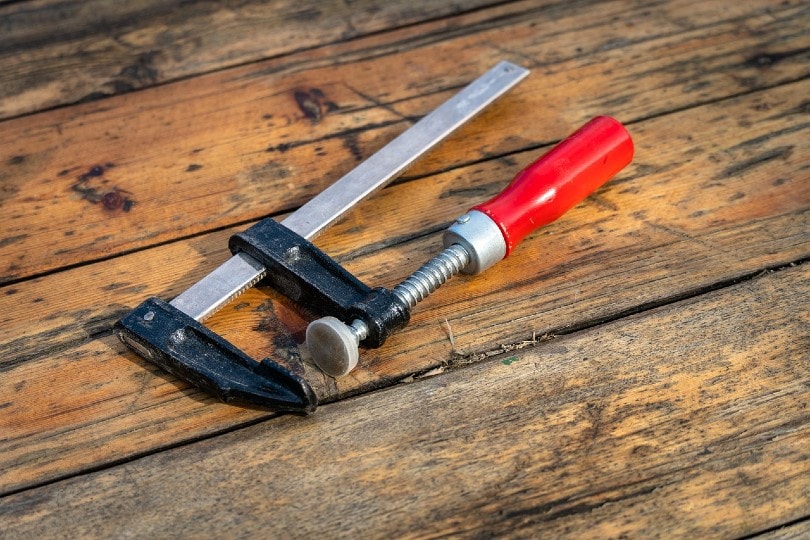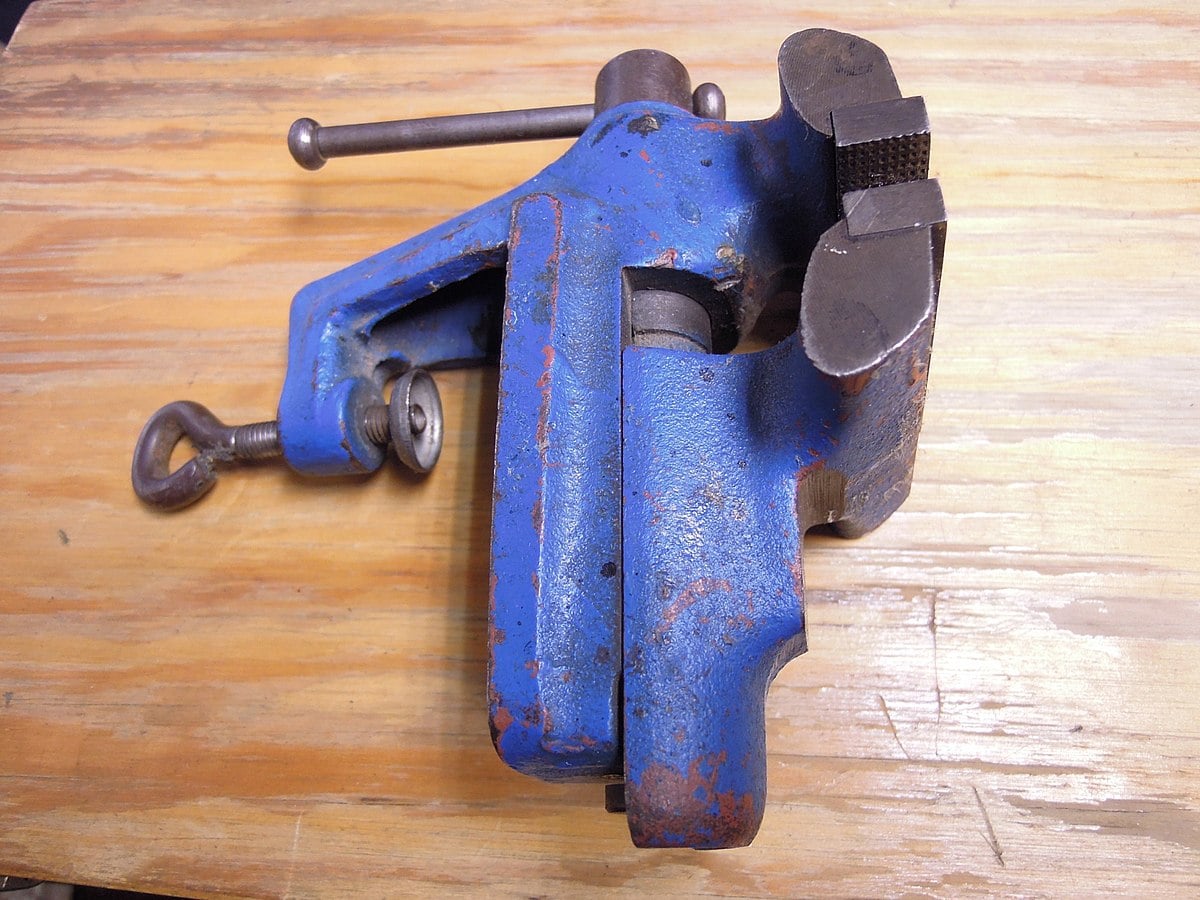12 Types of Clamps (with Pictures)
-
Pete Ortiz
- Last updated:

If you are considering building a wood shop or any other kind of workshop, one of the most important tools in it will be a clamp. It helps keep projects together while you build, glue, paint, and sand them. However, it’s not always easy to know what type of clamps you need and what types are available. If this sounds like your situation, keep reading as we look at several different kinds and what they can be used for to help you make an informed and educated purchase.
Types of Large Clamps
1. Sash Clamp
- Uses: Large projects, like doors and windows
Sash clamps are large, and woodworkers usually use them to fix doors and windows. It gets its name from its popularity for holding sash windows. It uses a long bar where the project rests, with a fixed jaw on one end and the movable one on the other. You use it to hold the project tight while working on it.
The downside is that it’s too large and bulky to use with small projects.
- Works well for large projects
- Too bulky for small projects
Types of Wood Clamps
2. Spring Clamps

- Uses: Carpentry, jewelry, DIY projects
A spring clamp is a fantastic all-purpose tool that is easy to use and holds the project tight until you remove it. Strong springs do the work. These clamps are available in many different sizes to hold different materials. They are also inexpensive, and you can find them in almost any woodshop. However, the jaws don’t open wide enough for thick or wide projects.
- Inexpensive
- Easy to use
- Available in many sizes
- Jaws don’t open as wide as some other types of clamps
3. Toggle Clamp
- Uses: woodwork, metalwork, drilling
The toggle clamp is similar to the fasteners that you use to hold a guitar case or briefcase closed. It uses a handle and a metal bar to pull two pieces together and hold them in place. You use the handle again to release the grip. The downside to this clamp is that you need to secure it to both sides of the project.
- Easy to operate
- Firm grip
- Requires securing it to the project
4. Pinch Dog
- Uses: Woodworking to create a neat glue line
The pinch dog is a special type of clamp used in woodworking to create a neat glue line. It has a square shape with tapered legs that you hammer into the wood near a fresh glue line to keep it in place while it dries. When the glue dries, you can remove the clamp. It works well when you need to glue many two by fours together to create a floor or other flat surface.
- Creates a neat and invisible glue line
- Easy to use
- Requires hammering them into the wood
5. Bench Clamp
- Uses: Woodworking
A bench clamp is a popular type of clamp in the woodshop. You fasten it directly to your workbench, which becomes the bottom jaw of your clamp. A lever then pulls down the top jaw to press your project into the bench, creating a fantastic, stable clamp. The only downside is that you must take your project to the clamp because it’s fixed in place.
- Creates a strong, stable clamp
- Easy to use
- Fixed in place
6. Strap Clamp
- Uses: Woodworking, clamping large loads
The strap clamp is a type that you frequently find in woodshops because it can be extremely helpful clamping objects that are difficult to clamp with other types. It works especially well for objects that lack a flat surface to fix a clamp to, and since it uses a strap, it’s possible to use this clamp on large projects.
- Suitable for large projects
- Easy to use
- Fixed in place
7. Bench Vise

- Uses: Woodworking
The bench vise is an easily recognizable clamp. It attaches securely to your workbench, and you use a large lever to provide plenty of clamping power. Most woodworkers use it to hold their project while they drill, sand, and complete other tasks, so it’s one of the most useful tools that you can purchase. Its simple but sturdy design means it will likely last a lifetime. The one downside is that it’s not portable.
- Suitable for large projects
- Easy to use
- Fixed in place
8. C Clamp

- Uses: Wide variety of uses
The C clamp is one of the most common and easy-to-use clamps that you can purchase for your workshop. You can find it in any industry, and it’s likely what many people think of when they think of a clamp. The design uses a steel frame shaped like a C. At the top of the C is the upper jaw. You raise the lower jaw using a threaded rod to clamp your project together.
This clamp is available in a wide variety of sizes, so there is no real downside other than that the thin handle doesn’t provide as much clamping strength as some other clamps.
- Extremely common
- Versatile
- Not much clamping power
Types of Automotive Clamps
9. Pneumatic Clamp
- Uses: Automotive industry
The pneumatic clamp uses an internal computer to provide plenty of clamping power. It also releases the clamp on a timer. The automotive industry developed it to increase production, but it’s used in many different fields today. The downside to this clip is that it can be extremely expensive and is more than what many people need.
- Computer-controlled clamping
- Expensive
Types of Machining Clamps
10. Step Clamp

- Uses: Milling and machining
Step clamps use bolts to fasten them to the surface and apply plenty of clamping pressure, so you typically find them on table saws and other similar equipment. Since they are part of that equipment, they are limited in their applications.
- Bolts provide plenty of clamping pressure
- Simple design that’s easy to use
- Can only use it on a table saw or similar equipment
11. Pipe Clamps
- Uses: Clamping pipes to a pipe hanger assembly
As the name suggests, a pipe clamp enables you to keep pipes in place while applying glue or completing other tasks. It’s highly adjustable and provides a firm hold in several positions. It’s also portable, so you can use it anywhere. The only downside is that its design prevents it from having many other uses.
- Enables you to grip pipes tightly
- Portable
- Specialized use
12. Marman Clamp
- Uses: Clamping pipes, antennas, swimming pools
Marman clamps are circular metal clamps that many people use to hold two pipes or cylinders together tightly. You can tighten a screw to tighten the band and increase clamping strength or loosen it to release pressure. You frequently see these clamps on antennas and swimming pools, where they hold the hoses to the filter and pump.
- Enables you to grip pipes or other cylinders tightly
- Limited uses
What Type of Clamp Should I Use?
The type of clamp that you should use will largely depend on the project that you are trying to complete. For example, if the project is large, you will need a big clamp, like the sash clamp or a bench clamp. These will enable you to use your entire workbench to keep the project stable. If you are trying to clamp pipes or another uneven surface, you will likely find strap clamps, pipe clamps, or Marman clamps to be the most useful. If you are trying to stock your workshop with something versatile, spring clamps and C clamps are your best bets. An anvil is another great choice for any workshop, and you will likely find it one of your most-used tools.
Summary
There are many types of clamps that you can use to keep your project together while you work on it. Though the number of clamps available can seem confusing, the good news is that you’re quite likely to find what you need to complete your project professionally. A bench vise, a few C clamps, and spring clamps should help any woodworker get started.
Featured Image Credit: Alexei_other, Pixabay
Contents



